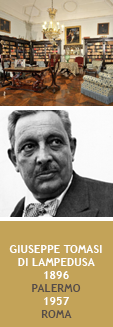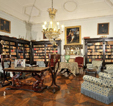(Palermo)
Palazzo Lanza Tomasi, which faces Palermo’s seafront, was built in the second half of the 17th century atop the Spanish military casemates behind the 16th century city walls. At the beginning of the 16th century, a crucial moment for the naval supremacy in the South Mediterranean, Spain fortified Sicilian cities with new walls. Ramparts were built for defence against the new artillery warfare. Palermo’s seafront was protected northwards by the fort of Castellamare, southwards by the bastion of Vega, and the bastion of Tuono was built in-between. The area behind the ramparts was militarized, and only in the second half of the 17th century the first palaces were built. The bastion of Tuono was pulled down around 1720, the bastion of Vega at the end of that century. The first buildings were the Branciforte di Butera palace and the Noviziato dei Crociferi. The Lanza Branciforte family owned the whole bastioned front from Porta Felice, one of the city gates, to the bastion of Tuono. The buildings behind the bastion were handed over to the Gravina family. The Gravinas then leased them to the Theatine fathers, who created there an Imperial College for the education of young aristocrats. The College was founded during the Spanish war of succession and in 1728, the foundation year, Palermo acknowledged as its king Charles VI of Habsburg. The College was closed down in 1768 and the palazzo was bought by Giuseppe Amato, Prince of Galati. The Prince unified the frontage on the sea in Vanvitelli style, adding the 50m long and 9 m wide terrace. In 1849, the palazzo was bought by Prince Giulio Fabrizio Tomasi di Lampedusa with the indemnity paid by the king of Naples for the expropriation of the island of Lampedusa. Giulio Fabrizio, an amateur astronomer, would be the model for the main character in “The Leopard”, the novel written by his great-grandson Giuseppe Tomasi di Lampedusa.
In 1862 the De Paces, rich ship-owners related to the Florio family, bought half of the palazzo and transformed it according to the taste of the period. An imposing staircase was created using marbles salvaged from the demolitions made for the building of the Massimo Opera House. A grand ballroom was built with a wooden floor made of alternating walnut and cherry staves.
In 1948 Giuseppe Tomasi di Lampedusa, who had lost his family palazzo in the bombing of April 23rd, 1943, bought the De Pace’s property and lived there until his death in 1957. His adoptive son Gioacchino Lanza Tomasi has unified the whole property and thoroughly restored the building. The furnishings of the ballroom and the writer’s library are mostly from the destroyed Palazzo Lampedusa, the furnishings, pictures and objects of the other rooms are from Palazzo Lanza di Mazzarino. The main charm of the palazzo rests in its location and the grandeur of serene space and glorious sunlight. Its interior decoration is typical of the great houses of Palermo’s aristocracy and contains a valuable collection of furnishings from the great Sicilian cabinet-makers.
The Lanza Branciforte family, of Swabian origin, moved to Sicily in the 13th century. Besides holding the title of Count of Mazzarino also held that of Prince of Butera, first among the peers in the Kingdom, and of Prince of Trabia, second among peers. The Tomasi family stands out in the 17th century for the mystical inclination and the devotion of its members, notably the Saint Duke, Giulio Tomasi, founder of the city of Palma di Montechiaro. Among his children were Cardinal Saint Giuseppe Maria Tomasi and the Venerable Sister Maria Crocifissa, author of mystical texts, buried in the Benedictine Monastery of SS Rosario in Palma di Montechiaro.








